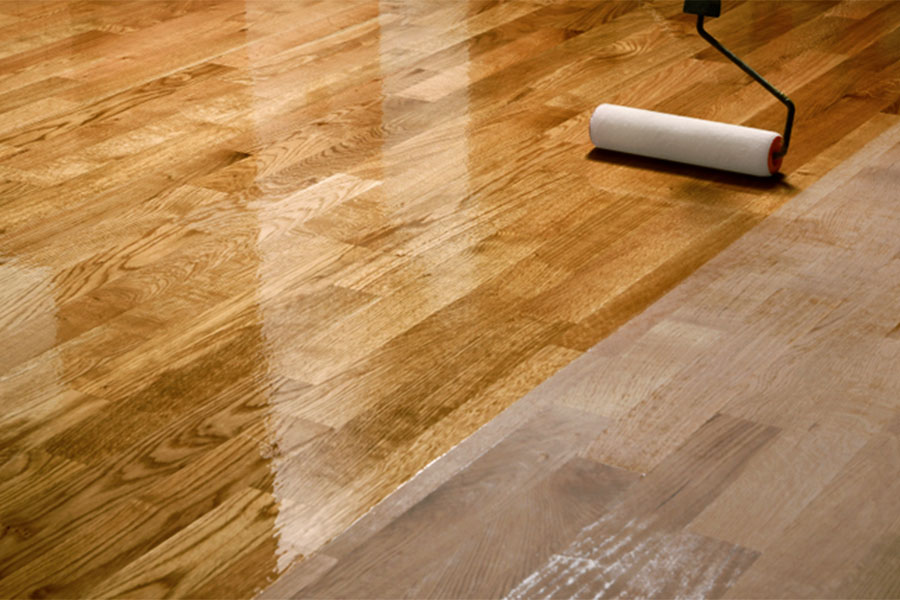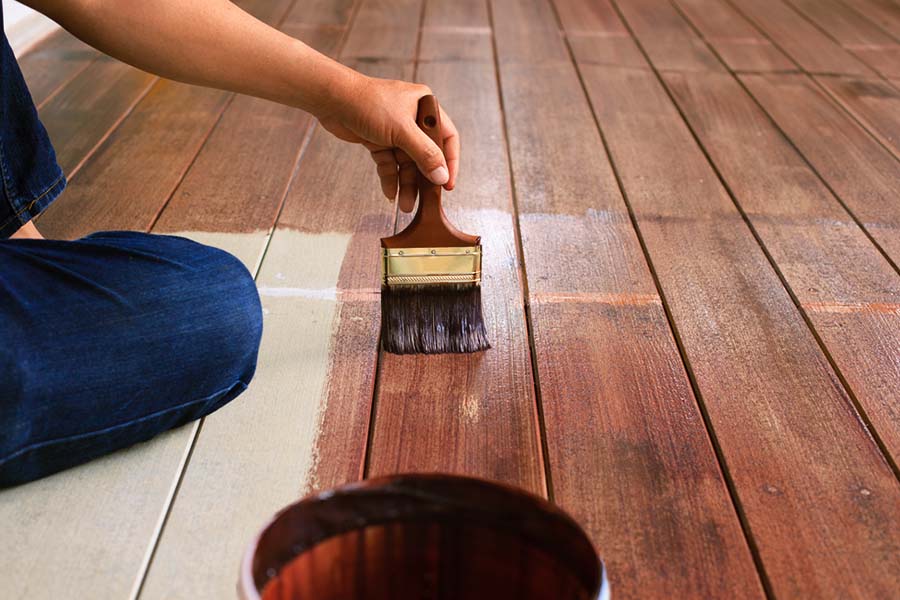Flooring Paint Ideas

Transforming the floors of your home can breathe new life into any space, but what if the options went beyond traditional flooring materials? Prepare to explore a world of creative possibilities with our flooring paint ideas.
In this comprehensive guide, we’ll dive into a realm of design potential, uncovering a diverse array of techniques and inspirations to revitalize your floors.
From selecting the right paint formulas to executing eye-catching patterns, this guide will equip you with ideas and knowledge to elevate your living spaces in unexpected ways.
Whether you’re seeking to refresh a tired hardwood surface or revamp a dated tile pattern, the power of paint can unlock a world of creative solutions. You can even create a one-of-a-kind design. Get ready to unleash your artistic flair while bringing warmth and character to your living spaces.

Source: shutterstock.com / Photo Contributor: taurusphoto
Some Creative Flooring Paint Ideas
Think beyond traditional wood or tile and consider bold patterns, geometric designs, or even artistic murals. You can use paint to mimic the look of expensive materials like marble or granite or add texture with techniques like stippling or sponging.
Don’t be afraid to experiment with colors that reflect your personality or the theme of the room. And remember, proper preparation and sealing are key to ensuring your painted floors stand up to daily wear and tear.
Classic Patterns
Painting your floors can open up a world of design possibilities, and some of the most timeless and visually striking options come in the form of classic patterns.
Checkerboard
One of the most enduring and iconic flooring patterns is the classic checkerboard. By painting alternating square tiles in contrasting colors, you can create a bold effect. This effect is visually striking and instantly adds character to any room.
This pattern works particularly well in kitchens, entryways, and other high-traffic areas. The bold design helps conceal minor scuffs and imperfections.
When executing a checkerboard pattern, it’s important to measure and plan the layout carefully to ensure perfectly aligned squares. Choosing the right paint formulas and finishes can greatly enhance the durability and longevity of the design.

Source: shutterstock.com / Photo Contributor: pics721
Stripes
Another classic flooring paint idea is the use of stripes. Painting parallel lines in contrasting or complementary colors can create a sense of depth and movement, instantly transforming the look and feel of a space.
Stripes can be applied in various orientations, such as running the length of the room or across the width, depending on the desired visual effect. Striped floors can be particularly striking in larger rooms.
The linear pattern can help to visually elongate the space. Careful consideration of the paint colors, line widths, and spacing can result in a stunning and cohesive design.
Geometric Shapes
Beyond classic checkerboards and stripes, painting geometric shapes and patterns on floors can add a modern and dynamic touch to any living space. From triangles and hexagons to more intricate tessellating designs, the possibilities are endless.
Geometric patterns can be used to create a focal point, accentuate architectural features, or simply add a sense of visual interest to an otherwise plain floor. Experimenting with different color combinations and scales can result in truly unique and eye-catching designs.
Faux Finishes
Painting floors can open up a world of creative possibilities, and one of the most intriguing approaches involves the use of faux finishes. By employing carefully crafted techniques, you can transform a simple floor into a stunning imitation of more expensive or elaborate materials.
Wood Grain
Replicating the natural beauty of wood on a painted floor can be a captivating option. By using specialized tools and paint techniques, you can create the illusion of a wood-paneled surface. This includes realistic-looking grain patterns and knots.
The key to a successful faux wood grain finish lies in the attention to detail and the layering of various paint colors and glazes. With a steady hand, you can replicate the natural variations found in genuine wood. This transformation turns a plain floor into a striking and convincing imitation.
Marble
Another alluring faux finish for floors is the imitation of marble. By carefully applying paint and using techniques like sponging, stippling, and veining, you can create the illusion of a luxurious, high-end marble surface.
The beauty of a faux marble floor lies in the unique and organic patterns that emerge, each being a one-of-a-kind masterpiece. This approach allows you to customize the color palette and veining to perfectly complement the overall design of your space without the hefty price tag of genuine marble.

Source: shutterstock.com / Photo Contributor: Serghei Starus
Tile
For those seeking the look of tiled floors without the associated cost and installation challenges, faux tile painting can be a captivating solution. By carefully mapping out a grid pattern and using a variety of paint techniques, you can create the illusion of individual tiles on your floor.
The versatility of faux tile painting allows you to experiment with different shapes, sizes, and color combinations. This enables you to achieve a truly personalized and visually striking result. This approach can be particularly useful in areas where real tile may not be a practical or feasible option.
Stenciled Designs
Painting floors can unlock a world of creative possibilities, and one such avenue is the use of stenciled designs. From classic geometric patterns to intricate motifs, stencils offer a versatile approach to transforming your floors.
Consider bold checkerboard or striped designs for high-traffic areas. Explore the potential of faux finishes that mimic the look of wood, marble, or tile. For a truly unique touch, dive into the realm of intricate stencil patterns, layering colors, and techniques to create one-of-a-kind masterpieces.
Color Blocking
Using bold colors can create dramatic and eye-catching effects, particularly on floors. Vibrant hues and strategic color-blocking patterns can transform a space, making a powerful statement.
Selecting complementary colors that sit opposite each other on the color wheel, such as blue and orange or red and green, creates a striking visual contrast. However, it’s important to balance these high-impact pairings with neutral tones or muted shades to prevent the design from feeling overwhelming.
Experimenting with different color combinations, block sizes, and proportions can help achieve the desired level of impact. It also helps in achieving balance and visual interest. Consider the overall aesthetic of the space.
Creative Techniques
The ombre painting technique can create unique and visually striking floor designs. It achieves this by transitioning smoothly from one color to another. This adds depth, movement, and a sense of fluidity to a space.
Splatter paint, on the other hand, can achieve a bold, energetic look. It adds character and personality, particularly in modern or industrial-inspired settings. Incorporating abstract painting techniques on floors can convey a contemporary, gallery-inspired aesthetic.
This is achieved by embracing the freedom and spontaneity of abstract art. It’s through a balance of structure and fluidity, using geometric shapes, bold brushstrokes, and unexpected color combinations. Layering different painting techniques like dripping, sponging, or stenciling adds depth and complexity to the design.
Practical Considerations
Proper surface preparation is crucial when painting floors. It sets the foundation for a successful and long-lasting outcome. This involves thoroughly cleaning the surface to remove any dirt, debris, or existing coatings that could interfere with the paint’s adhesion.
Depending on the floor material, additional steps may be necessary to create a smooth, uniform base. Selecting the right paint and sealant is essential for achieving durable and long-lasting results.
Factors such as the floor material and expected level of foot traffic should be considered when making this decision. It often recommends durable, specialized floor paints and a clear sealant. This locks in the paint and creates a smooth, easy-to-clean finish.
Maintaining painted floors through regular cleaning is essential. It’s also important to address minor scratches or chips promptly. Periodically reapplying sealant can help extend the lifespan of the painted surface. This also preserves its beauty and function over time.

Source: shutterstock.com / Photo Contributor: stockphoto mania
Conclusion
In conclusion, the possibilities of flooring paint ideas are truly boundless. Through the insights and inspiration provided in this article, we hope you have realized the transformative potential of paint to revitalize your floors in remarkable ways.
Whether you choose to embrace bold patterns or experiment with unique color palettes, the power of paint can breathe new life into any living space. You can also opt for a more subtle refinement, leaving your home feeling fresh, vibrant, and uniquely your own.
This article has aimed to provide you with insights to help you unleash the true potential of paint and create a space that truly reflects your personal style and vision.
